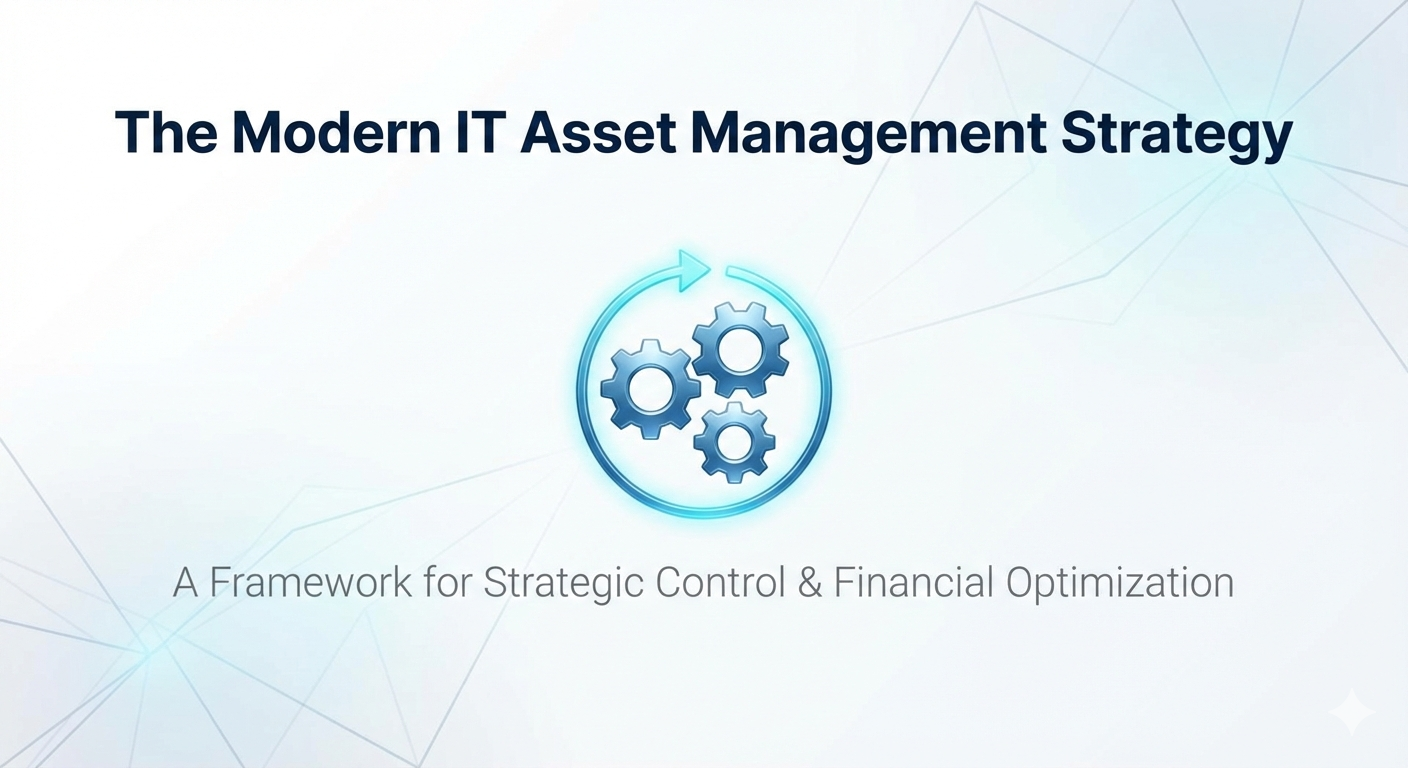You know that feeling? The one that hits late on a Friday afternoon when finance asks for a report on software spend, and you realize you have no single source of truth. Or when a laptop containing sensitive data goes missing from a remote employee, and you can’t confidently say what was on it or when it was last patched.
It’s a quiet chaos. A sprawling inventory of hardware, software licenses, and cloud subscriptions that feels less like a managed portfolio and more like a digital junk drawer.
Look, the old way of thinking about IT Asset Lifecycle Management (ITALM)—as a simple process of buying, using, and retiring computers—is dangerously outdated. In today’s world of SaaS sprawl, hybrid workforces, and intense budget scrutiny, a weak asset strategy isn’t just inefficient; it’s a direct threat to your bottom line and your security.
Here’s the brutal truth: without a systematic approach, you are likely hemorrhaging money. Industry analyses consistently show that a well-implemented ITAM strategy can reduce costs by up to 30% per asset in the first year alone.
Think about that. For every hundred thousand dollars you spend on IT, $30,000 could be leaking out through redundant software, ghost assets, and poor disposal practices. This article isn’t another high-level guide. It’s a strategic blueprint for plugging those leaks and turning your IT asset management from a cost center into a powerful engine for financial optimization and operational control.
Key Takeaways
• Financial Impact is Massive: A proper IT asset lifecycle strategy can cut costs by 30% in the first year and recover 25-35% of the original equipment cost at disposal. • The Old Model is Obsolete: Traditional 5-stage models fail to address modern challenges like cloud costs and SaaS sprawl. We propose a 7-stage model that adds a dedicated Financial Optimization & FinOps phase. • Modern Threats Require Modern Solutions: SaaS waste is a growing crisis, with 35% of IT teams reporting an increase in the last year. Your strategy must actively manage software, cloud, and hardware assets in one unified framework. • Sustainability is Now a Business Metric: ESG (Environmental, Social, and Governance) compliance is no longer optional. A strategic IT asset disposition (ITAD) plan is crucial for both regulatory compliance and value recovery.
Table of Contents
• The Next-Generation 7-Stage IT Asset Lifecycle Model
• Stage 1: Strategy & Planning
• Stage 2: Procurement & Acquisition
• Stage 3: Deployment & Onboarding
• Stage 4: Utilization & Monitoring
• Stage 5: Financial Optimization & FinOps (The Critical New Stage)
• Stage 6: Maintenance & Support
• Stage 7: Decommissioning & Disposal
• Strategic Deep Dive: Mastering Modern ITAM Challenges
• Tackling the SaaS Sprawl Crisis
• ESG & Sustainable IT: Turning Old Tech into New Value
• Securing the Hybrid Workforce
• The Blueprint for Evaluating ITAM Software
• Building Your Policy: An Implementation Roadmap
• Stop Reacting, Start Strategizing
The Next-Generation 7-Stage IT Asset Lifecycle Model
Most guides talk about a five or six-stage lifecycle. They’re not wrong, just incomplete. They were designed for a world where IT assets were physical things you could see and touch. To truly control your modern IT estate, you need to evolve. We’ve rebuilt the model to include a crucial new stage focused entirely on financial management.
Stage 1: Strategy & Planning
This is where you stop buying things and start building a framework. Before a single dollar is spent, you need to define the “why” behind every asset.
• Needs Analysis: What business function does this asset serve? Who needs it, and why? This isn’t just about hardware specs; it’s about aligning technology with real business goals. Does the sales team actually need the premium laptop model, or will the standard build suffice? • Policy Creation: This is your rulebook. It should define standard hardware models, software approval processes, refresh cycles (e.g., laptops every 3 years, servers every 5), and security requirements. A clear policy eliminates guesswork and rogue IT spending. • Budgeting: Forecast your needs for the coming fiscal year. A mature strategy moves beyond simple replacement costs and accounts for software renewals, cloud consumption, and potential price increases.
Stage 2: Procurement & Acquisition
With a plan in place, purchasing becomes strategic, not reactive. The goal here is to get the best possible value, which doesn’t always mean the lowest price.
• Vendor Management: Consolidate your vendors. Building strong relationships with a few key suppliers can lead to better pricing, preferential support, and more favorable terms. • Standardization: Stick to your pre-defined hardware models. This simplifies support, reduces the number of unique images you need to maintain, and allows for bulk purchasing discounts. • Lease vs. Buy Analysis: For certain assets, leasing can be a smarter financial move. It converts a large capital expenditure (CapEx) into a predictable operational expense (OpEx) and simplifies the refresh process.
Stage 3: Deployment & Onboarding
This is the first moment an asset provides value to an employee. A smooth deployment sets the tone for the user’s entire experience. In a hybrid world, this stage has become infinitely more complex.
• Zero-Touch Provisioning: For remote employees, shipping a laptop that automatically configures itself upon its first internet connection is a game-changer. It saves countless IT hours and gets new hires productive from day one. • Asset Tagging & Tracking: As soon as an asset is unboxed, it needs to be entered into your ITAM system. This includes the user it’s assigned to, its physical location, and its network details. This is your foundational layer of visibility. • User Training: Don’t just hand over a laptop. Ensure the user understands security policies, how to access support, and best practices for using company-approved software.
Stage 4: Utilization & Monitoring
An asset is deployed. Now what? You need to know if it’s being used effectively, securely, and efficiently.
• Software Metering: Are people actually using that expensive Adobe Creative Cloud license you bought them? Software metering tools can track usage and identify licenses that can be harvested and reallocated, preventing you from buying new ones unnecessarily. • Performance Monitoring: Is a user’s machine constantly running slow? Proactive monitoring can identify hardware issues or resource-heavy applications before they result in a flood of help desk tickets. • Security & Patch Management: This is non-negotiable. Your ITAM system must track the patch status of every single device. An unpatched machine is an open door for attackers.
Stage 5: Financial Optimization & FinOps (The Critical New Stage)
Here’s where our model diverges. We’re elevating financial management from a background task to a dedicated, strategic stage. Why? Because your biggest financial black holes are no longer just hardware—they’re in the cloud and SaaS subscriptions.
According to Deloitte, a connected asset lifecycle can reduce operational expenses by up to 15% and capital expenditures by 8%. This is where you realize those savings.
• Cloud FinOps: This is the practice of bringing financial accountability to the variable spend model of the cloud. It involves continuous monitoring of your cloud consumption, identifying wasted resources (like idle virtual machines), and rightsizing services to match actual demand. This requires collaboration between IT, finance, and engineering. • SaaS Rightsizing: It’s easy to sign up for a new SaaS tool. It’s much harder to track and manage them all. This process involves regularly auditing all SaaS subscriptions, identifying overlapping functionalities (do you really need three different project management tools?), and downgrading or eliminating licenses that aren’t providing value. • Depreciation Scheduling: For physical assets, tracking depreciation is a core accounting function. Your ITAM platform should integrate with your financial systems to automate this, ensuring accurate bookkeeping and helping you plan for future capital expenditures. For more on this, consider seeking expert guidance on cloud computing to ensure you’re maximizing your investment.
Stage 6: Maintenance & Support
Even with perfect planning, things break. This stage is about keeping your assets—and your people—running smoothly and productively.
• Help Desk Integration: When a user submits a support ticket, your help desk technician should be able to instantly pull up the complete history of their assigned asset: its specs, repair history, and software installations. This dramatically speeds up troubleshooting. • Warranty & Contract Management: Your ITAM system should track all warranty expiration dates and support contract renewal dates. Getting an alert 90 days before a critical server’s support contract expires prevents costly lapses in coverage. • Predictive Maintenance: For critical infrastructure, modern tools can use AI and machine learning to predict potential failures before they happen, allowing you to schedule maintenance during off-hours and avoid catastrophic downtime.
Stage 7: Decommissioning & Disposal
When an asset reaches the end of its useful life, you can’t just toss it in a closet. This final stage is crucial for data security, environmental responsibility, and value recovery.
• Secure Data Wiping: Every device being retired must have its storage professionally and certifiably wiped to Department of Defense standards. Failure to do so is a massive data breach waiting to happen. • IT Asset Disposition (ITAD): Don’t just recycle old equipment. Strategic ITAD partners can refurbish and resell your old hardware. This is where the numbers get really interesting: you can often recover 25-35% of the original equipment investment. That recovered cash can be funneled directly back into your IT budget. • License Reharvesting: Before a machine is wiped, its software licenses (if transferable) must be recovered and returned to your available pool. This simple step saves thousands in unnecessary software repurchases.
Strategic Deep Dive: Mastering Modern ITAM Challenges
The 7-stage model provides the “what.” This section covers the “how” for the three biggest challenges facing IT leaders today.
Tackling the SaaS Sprawl Crisis
That 30-day free trial of a new marketing tool is now a $500/month line item nobody approved. Sound familiar? According to the Flexera 2025 State of ITAM Report, 35% of IT teams reported an increase in SaaS waste last year. It’s an out-of-control firehose of spending.
Your Action Plan:
- Discover: You can’t manage what you can’t see. Use a SaaS management platform (SMP) or integrate your single sign-on (SSO) and expense reporting systems to get a full inventory of every application being used.
- Rationalize: Analyze the discovered apps. Identify redundancies, unused “shadow IT” subscriptions, and opportunities to consolidate users under a single enterprise plan.
- Govern: Create a formal software request and approval process. All new SaaS purchases must go through IT and procurement to ensure they meet security standards and don’t duplicate existing capabilities.
ESG & Sustainable IT: Turning Old Tech into New Value
Environmental, Social, and Governance (ESG) criteria are increasingly important for investors, customers, and regulators. Proper ITAD isn’t just good for the planet; it’s good for your brand and your budget.
Your Action Plan:
- Partner with a Certified ITAD Vendor: Look for vendors with certifications like R2 (Responsible Recycling) or e-Stewards. They guarantee that your assets are handled in an environmentally responsible and data-secure manner.
- Prioritize Resale and Reuse: The most sustainable option is to give hardware a second life. Your ITAD partner should have a robust network for remarketing your equipment to maximize its resale value.
- Demand Chain of Custody Reporting: For every batch of assets you dispose of, you should receive a detailed report confirming that all data was destroyed and outlining where each component ended up—resold, repurposed, or recycled.
Securing the Hybrid Workforce
Your security perimeter is no longer the four walls of your office. It’s every home network, coffee shop, and airport Wi-Fi your employees connect to. Asset management is now a foundational pillar of cybersecurity.
Your Action Plan:
- Endpoint Visibility is Key: Your ITAM tool must give you real-time visibility into every device, regardless of its location. You need to know its patch level, what software is installed, and whether its security configurations are compliant.
- Automate Compliance: Set policies that automatically flag or quarantine devices that fall out of compliance (e.g., antivirus is disabled, a critical patch is missing).
- Integrate with Your Security Stack: Your ITAM data should feed directly into your security information and event management (SIEM) system. When a security alert fires, your team needs immediate context on the affected asset and its user. This requires implementing robust cybersecurity protocols across your entire infrastructure.
The Blueprint for Evaluating ITAM Software
Choosing the right tool is critical. When you’re evaluating vendors, don’t get distracted by flashy dashboards. Focus on the core technical capabilities that will actually drive value.
Use this checklist to cut through the marketing noise:
• Automated Discovery: Can the tool automatically discover all hardware and software on your network (including cloud instances and mobile devices) without manual intervention? • CMDB/ITSM Integration: Does it seamlessly integrate with your existing IT Service Management platform (like Jira or ServiceNow)? Your asset data and service desk data must speak the same language. • Cloud & SaaS Metering: Can it connect via API to your major cloud providers (AWS, Azure) and SaaS applications to pull in real-time usage and cost data? • Lifecycle Workflow Automation: Can you build automated workflows for processes like employee onboarding/offboarding, hardware requests, and disposal approvals? • Financial Management Features: Does it include modules for contract management, warranty tracking, depreciation calculation, and chargeback reporting? • ERP & HRIS Connectivity: Can it sync with your ERP for financial data and your HR system to automatically assign/reclaim assets as employees join or leave the company?
Building Your Policy: An Implementation Roadmap
A strategy is useless without a policy to enforce it. Your ITALM policy should be a formal, living document that outlines the rules of the road for everyone in the organization.
A strong policy includes: • Scope: What assets are covered (hardware, software, cloud, mobile)? • Roles & Responsibilities: Who is responsible for what? (e.g., IT for procurement, department heads for budget approval, users for asset security). • Financial Procedures: How are assets budgeted for, purchased, and tracked financially? • Asset Classes: Defines the standard models and refresh cycles for different types of assets. • Security & Disposal Procedures: Mandates for data wiping, encryption, and the use of certified ITAD partners.
Putting this all together can feel overwhelming. It often requires a dedicated team and deep expertise that many in-house IT departments simply don’t have the bandwidth for.
Frequently Asked Questions
Q1: Isn’t a formal ITAM strategy only for large enterprises? Absolutely not. The principles scale. A 30-person company might not need a complex enterprise tool, but it absolutely needs a process for tracking software licenses, managing laptop refreshes, and securely disposing of old hardware. The financial waste from poor ITAM is proportional—a 30% savings is significant for any size business.
Q2: How long does it take to implement a full ITAM program? It’s a journey, not a destination. A foundational implementation (getting discovery tools in place and building an initial inventory) can take 3-6 months. Maturing the program with workflow automation and deep financial integration can take 12-18 months. The key is to start with the areas of highest risk and highest potential ROI, like software license management.
Q3: Can we handle this entirely in-house? It’s possible, but it’s a huge undertaking. It requires dedicated personnel with expertise in procurement, IT security, finance, and logistics. Many small and medium-sized businesses find that partnering with a managed services provider gives them access to enterprise-grade expertise and tools for a fraction of the cost of building an in-house team.
Stop Reacting, Start Strategizing
The chaotic, reactive approach to IT asset management is a relic of the past. In an era where every dollar is scrutinized and every endpoint is a potential security risk, a proactive, data-driven strategy is essential for survival and growth.
By adopting a modern, 7-stage lifecycle model, you can transform your IT assets from a sprawling, expensive mystery into a tightly controlled, financially optimized portfolio. You can stop plugging leaks and start building a foundation for scalable, secure, and sustainable growth.
This isn’t just about organizing your inventory. It’s about taking control of a huge slice of your company’s operational budget and risk profile. If you’re ready to move from reactive firefighting to strategic management, the first step is a conversation. Working with a strategic managed IT partner like KME Systems can provide the framework, tools, and expertise to build an asset management strategy that truly supports your business goals.





